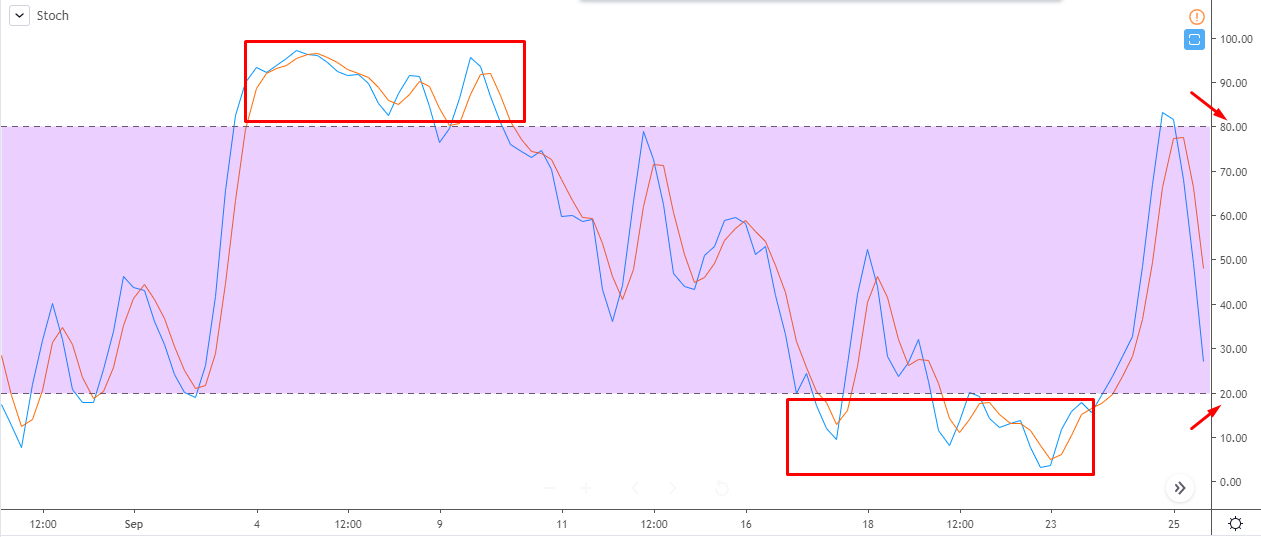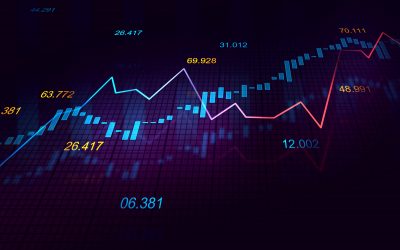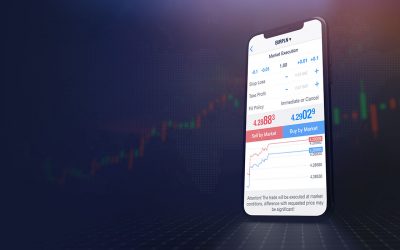As soon as we learn about trading, it is so tempting to try out the whole lot of indicators. They seem to be so simple and reliable, that you just want to fund an account immediately and start trading, with no system and practice whatsoever.
But remember: don’t try to walk before you can crawl. In this review, we’re gonna talk about how to leave out any mistakes you could have made through negligence, if you started trading using indicator signals with no system.
You have an option of 3 instruments. Each of them is designed for specific conditions:
- ЕМА 8/21 is best for trend trading.
- Bollinger bands are best for flat market trading.
- Stochastic is the tool for trading against the trend.
We are going to have a look at how these indicators work, and we’ll make up simple strategies for using them in real accounts. Let’s begin with the most profitable kind of trading, the trend trading.
EMA: what is it?
EMA stands for Exponential Moving Average. Unlike simple Moving Average (MA), ЕМА is built up exponentially. This means it gets adapted faster to the market changes. In the ЕМА formula, recent data have more significance than the older ones:
 The screen shot above contains two moving averages: the simple moving average in blue, and an exponential moving average in red.
The screen shot above contains two moving averages: the simple moving average in blue, and an exponential moving average in red.
Please note: the red moving average line is always closer to the price. This demonstrates that EMA is always closer to current market data, hence it is more accurate than a simple MA.
ЕМА 8/21 are showing the trend
For the trend signals to be more accurate, traders place 2 moving averages in the chart with different time-frames: 8 and 21.
The first one, ЕМА 8, is “fast” and is best at showing the state of the local trend. Another one, ЕМА 21, is best for showing the general trend.
When the price is higher than EMA, there is an uptrend, when the price is lower, there is a downtrend.
 ЕМА 8 / 21 show the following:
ЕМА 8 / 21 show the following:
- When the trend is
- When the trend is getting
- When the trend is overbought / oversold, and it’s time for pullback.
You can examine these subtle details in the following picture:
 ЕМА 8/21 demonstrate when the trend is reversing, when it is getting stronger or weaker
ЕМА 8/21 demonstrate when the trend is reversing, when it is getting stronger or weaker
How to trade ЕМА 8/21: Major Strategy
To earn with the ЕМА, one needs to enjoy the trend trading and use indicators as support / resistance:
 ЕМА 8/21 — resistance for the price
ЕМА 8/21 — resistance for the price
For such a strategy, a moving average is the last link in a chain:
- First, we are looking for a regular support/resistance area.
- Then we are checking if we really are entering the trend, not the flat market.
- Checking, if there is a round level at the entrance. It’s good to have it, but this is not mandatory.
- If there are candles with shadows or some other reversal pattern you know well.
And only then ЕМА 8 / 21 will appear in the chart. For instance, if we intend to buy long, the price should be higher than the EMA and reach out higher from it:
 ЕМА 8-21: The Strategy
ЕМА 8-21: The Strategy
So, to make money using EMA, we need 3 or 4 things to overlap:
- Trend.
- Area.
- Round-number level (optional).
- Reversal pattern (candles, bars, a renko chart).
And the first indicators strategy is ready. Start with trying the system in the demo account first. When you are ready, open a real account. And adapt your strategy by adding new rules and observations.
The best indicator for the flat market: Bollinger bands
So, we now have a tool for trend trading, but what if we want to do the flat market trading? The simplest and the most reliable indicator for such a trade is Bollinger bands:
 It’s hard to imagine, but this indicator was developed by John Bollinger, the inventor of this tool, as early as in 80-s of the past century! 40 years went by, and the indicator is still working: this means that technical principles of the charts (meaning human behavior) have not changed, not a speck.
It’s hard to imagine, but this indicator was developed by John Bollinger, the inventor of this tool, as early as in 80-s of the past century! 40 years went by, and the indicator is still working: this means that technical principles of the charts (meaning human behavior) have not changed, not a speck.
How Bollinger bands work
This indicator consists of 3 bands: the upper, the middle, and the lower bands.
 The middle band is a 20-period moving average (MA 20); the upper and the lower bands are just the same moving average with double deviation: above and below the moving average accordingly.
The middle band is a 20-period moving average (MA 20); the upper and the lower bands are just the same moving average with double deviation: above and below the moving average accordingly.
As you place the Bollinger bands on the chart, the price kind of gets surrounded by the indicator. Notice: everything beyond the bands is reversal points.
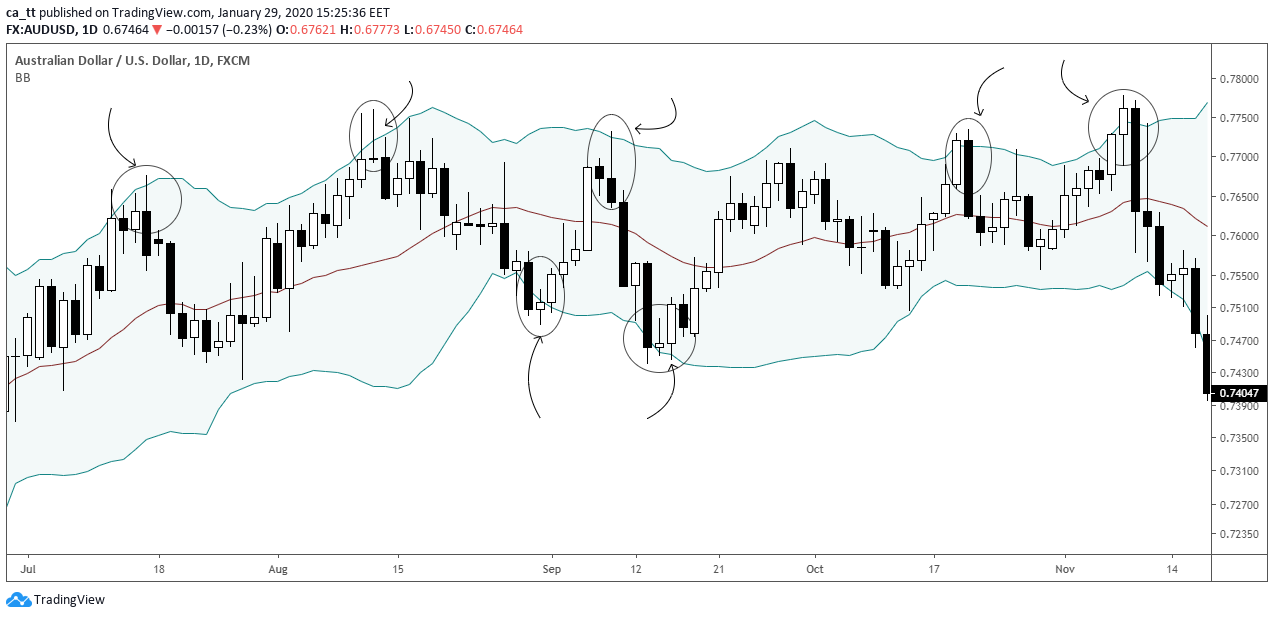 But this regularity works not all the time — only in the flat market. When the price is trending, you need to watch out for the indicator’s middle line — it is becoming a support/resistance:
But this regularity works not all the time — only in the flat market. When the price is trending, you need to watch out for the indicator’s middle line — it is becoming a support/resistance:
 How to earn with Bollinger bands: a strategy for the start
How to earn with Bollinger bands: a strategy for the start
Trending market won’t do, we need the flat market here. How can we recognize that the trend has developed into the flat market? Have a look at the chart:
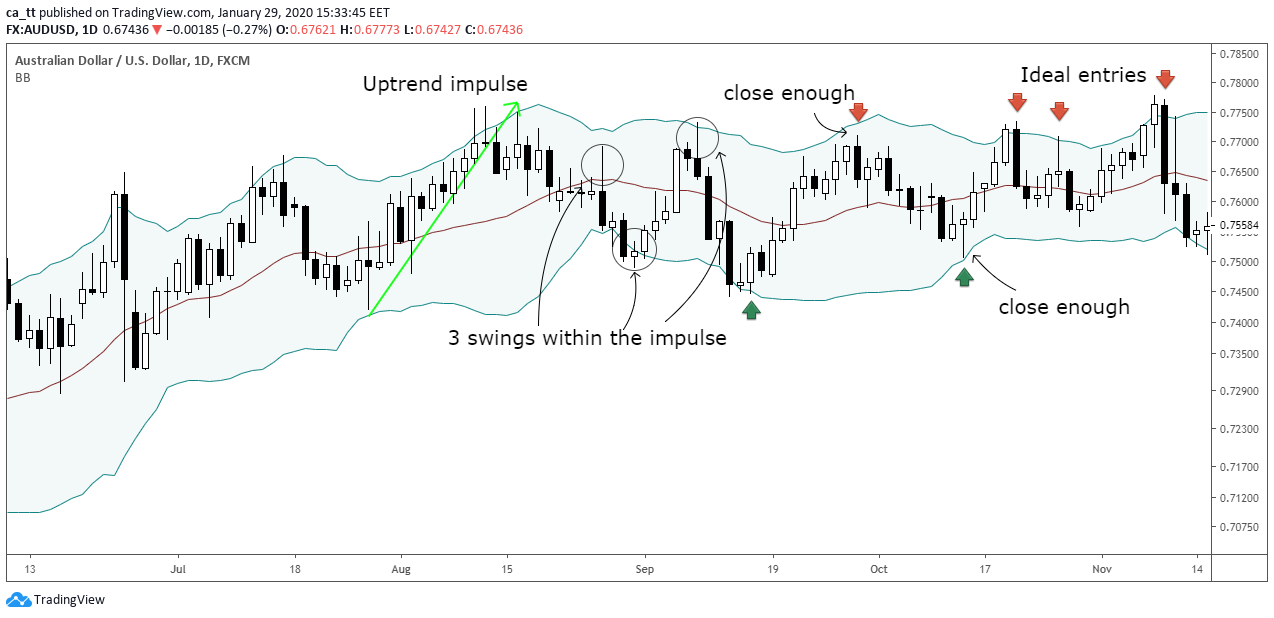 Instruction: Distinguishing a trend from a flat market
Instruction: Distinguishing a trend from a flat market
In the trending market, the price continuously refreshes the top or the bottom. In the flat market, however, the price starts hanging around: swings appear within the prior impulses.
Have a look at the screen shot above: after a strong uptrend impulse, 3 swings appear within it. This is the first acknowledgment that the market is becoming flat.
The second acknowledgment is that the price starts moving sideways, from left to right, in the shape of V, U or W.
The third signal is that the price keeps crossing the middle Bollinger band.
When all the prerequisite are satisfied, the way out should be sought: the reversal signal will either go beyond the bands, or will touch them with its shadow. As in the example below:
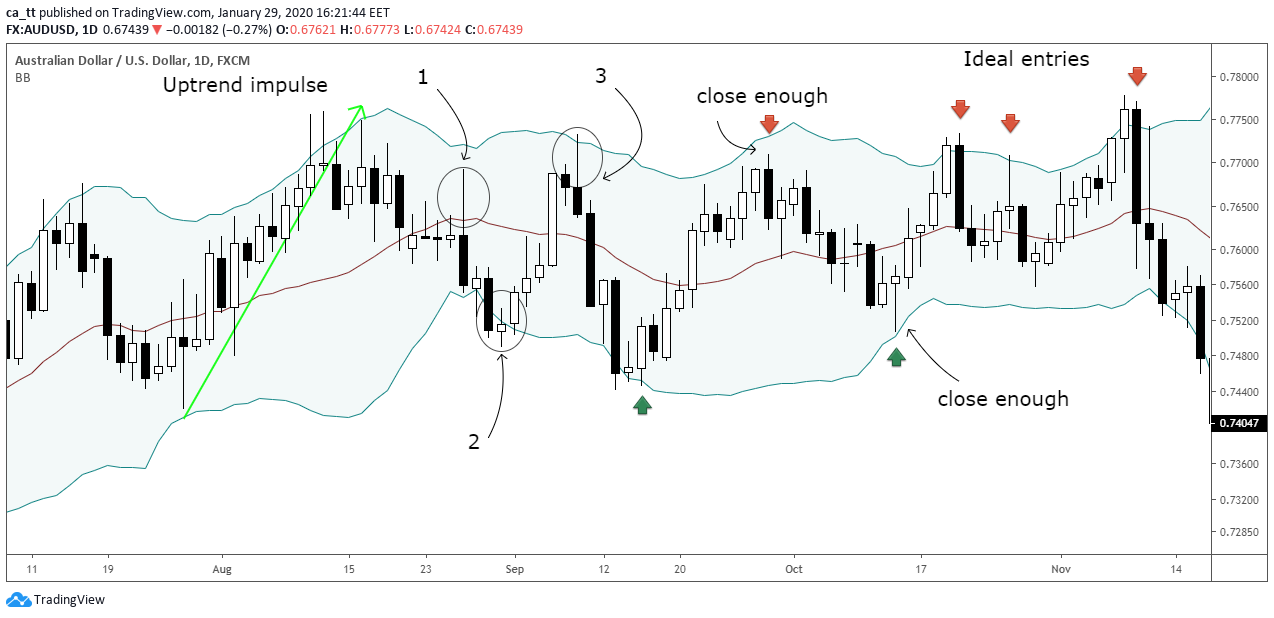 The Algorithm
The Algorithm
- 3 swings appeared within the uptrend impulse.
- The price is definitely moving sideward.
- The chart is moving in the shape of U, V, W.
- The price crosses the moving average.
- There is a reversal candle setup, whether with or without shadow.
- The candle is either close enough to the boundary (a reasonable entry signal) goes beyond it (a strong entry signal).
Your strategy for the flat market is ready.
When is the market reversal expected? Stochastic knows
The Stochastic oscillator is a momentum indicator: it shows how quickly the price is changing.
 This indicator is old enough: it was developed back in 1950-s, 30 years before Bollinger bands!
This indicator is old enough: it was developed back in 1950-s, 30 years before Bollinger bands!
There is a 0 to 100 scale to the right of the indicator. When it drops down below 20, this indicates that the price is oversold and is ready for the upward reversal. When it rises above 80, this shows that the price is overbought and is likely to move downwards soon:
Overbought and oversold market is just the first part of the process. The second part is divergence.
Stochastic Divergence
Divergence is when the indicator and the price diverge:
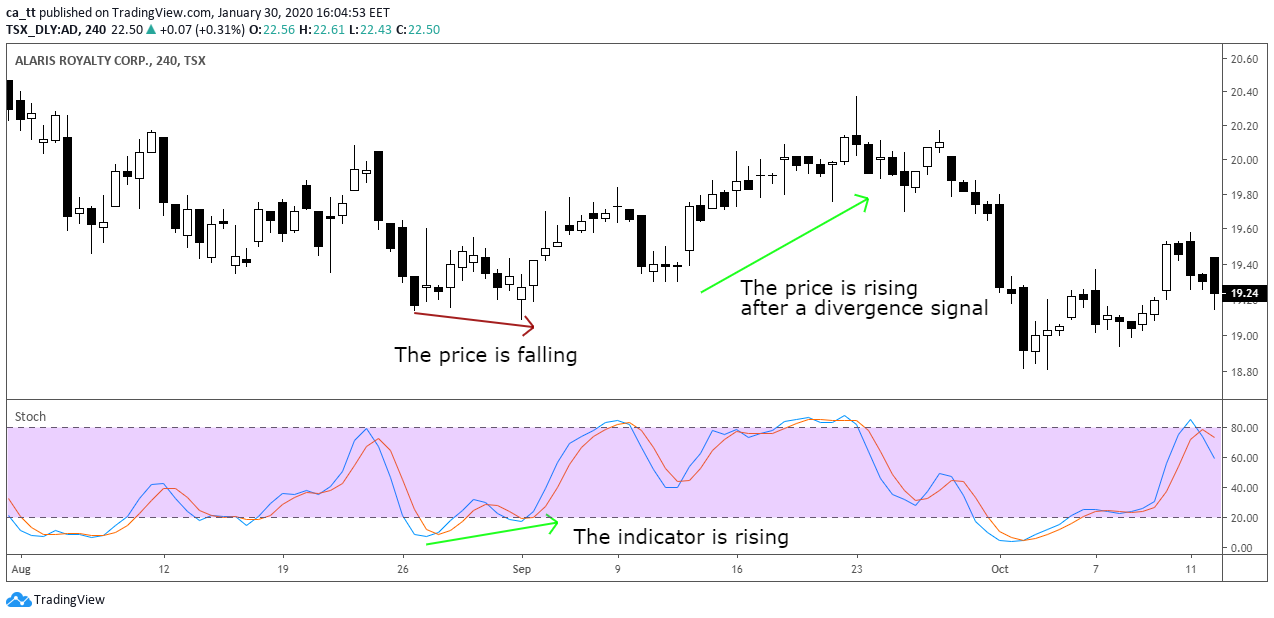 This is what we see in the picture: the price is falling, but Stochastic shows the momentum is growing. Soon the trend is changing into the uptrend, and the price is rising.
This is what we see in the picture: the price is falling, but Stochastic shows the momentum is growing. Soon the trend is changing into the uptrend, and the price is rising.
Please note: the divergence appeared in the oversold zone, that is, according to the indicator, the price was about to grow. This is yet another reversal acknowledgment, so Stochastic is virtually a turnkey system. Optionally, you may add the supply/demand zones, and here you go — you’ve got a strong trading strategy:
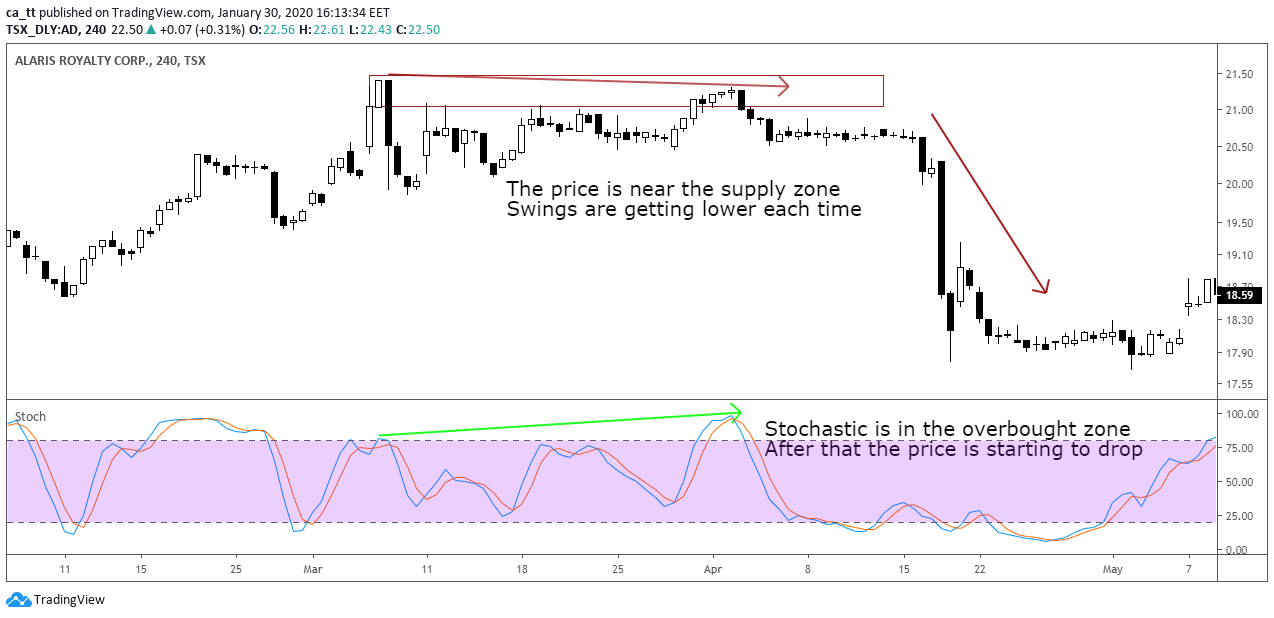 Stochastic: Trading Strategy
Stochastic: Trading Strategy
- Indicator is in the overbought / oversold.
- The price and Stochastic show different things: one of them is growing, another is reducing, or vice versa.
- There is a demand / supply area drawn by 2-3 swings.
What other easy strategies for start are out there
We have figured out the functioning of the three popular indicators: ЕМА 8/21, Bollinger bands, and Stochastic. Now you have 3 strategies available for different market conditions, formulated in an easy and consistent algorithm.
And the last thing: trading with indicators can always be automated. You are free to develop your own trading robot, or get an existing one from our collection of free expert advisers:
- Ema 6.21, which is moving average based.
- LiveRSI, based on well-known Relative Strength Index.
- MACD-Pattern, which is trading based on signals of MACD-indicator that is similar to Bollinger bands and is suited for flat market trading.
An expert robot adviser requires some moderate amount of time and patience. After you are done with downloading and installing, and testing it against some background data, you should go ahead and attach it to your account to have it generate some prudential profit.
Don’t forget to consider the key news in your trading. We always warn our traders about it in our daily analytics.
Keep training and turn your favorite indicator into your money-making tool




